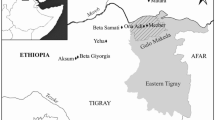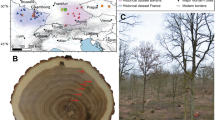Abstract
It is often argued that the repetitive removal of branches to improve the quantity and the quality of wood, i.e. woodland management, has been practiced in Europe from the Mesolithic and/or Neolithic onwards. The Neolithic pile dwelling of Alvastra in Sweden has been mentioned in textbooks as a classical example of this practice. The conclusion about woodland management at Alvastra was primarily based on palynological data, which do not provide any direct evidence. Is it correct to conclude that woodland management was practiced at Alvastra? To investigate that, this paper reviews the previous arguments and interpretations, focusing on wood data, and by comparing archaeological data with modern wood data. First, the assemblage of vertical posts from the latest excavations at Alvastra include a wide range of taxa, showing opportunistic use of the woody vegetation. Second, while the dendrochronological analysis of Quercus and Ulmus carried out in the 80 s has clearly indicated that the trees used for the posts grew under highly similar conditions and that particularly many Quercus trees started to grow more or less at the same time, the reason for the partially simultaneous start of growth remains unknown, and the posts used for the construction of the site do not provide evidence of repetitive removal of trunks from stools. Finally, analysis of the age/diameter data of the Corylus wood indicates the use of branches from unmanaged vegetation, while age data of Salix do not support management either. In conclusion, the data do not support the hypothesis of woodland management at Neolithic Alvastra, and it is most likely that people did not practice woodland management. This outcome corresponds to the conclusions in some of the previous publications about the site.


reproduced with permission from The Royal Swedish Academy of Letters, History and Antiquities. M is the mean curve of all the trunks. The other letters indicate groups consisting of one or multiple trunks that were cut in the same year. A: N = 16, B: N = 4, C: N = 1; D: N = 5, E: N = 4; F: N = 1, G: N = 10; H: N = 3; I: N = 3

Reproduced with permission from The Royal Swedish Academy of Agriculture and Forestry (KSLA). N = number





Similar content being viewed by others
References
Allaby M (2006) A dictionary of plant sciences, 2nd edn. Oxford University Press, Oxford
Bartholin TS (1978) Alvastra pile dwelling: tree studies. The dating and the landscape. Preliminary results. Fornvännen 73:213–219
Bartholin TS (1983) The combined application of dendrochronology and wood anatomy. In: Eckstein D, Wrobel S, Aniol RW (eds) Dendrochronology and archaeology in Europe. In: Proceedings of a workshop of the European Science Foundation (ESF), held in Hamburg April 28–30, 1982. Wiedebusch, Hamburg, pp 79–92
Bartholin T (1987) “Oak and willow”: Active and passive periods at Alvastra pile dwelling. A result of dendrochronological and wood anatomical investigations. In: Burenhult G, Carlsson A, Hyenstrand Å, Sjøvold T (eds) Theoretical approaches to artefacts, settlement and society. Studies in honour of Mats P. Malmer. BAR International Series 366(i). Archaeopress, Oxford, pp 123–132
Bartholin T (1996) Den neolitiske hasselskov. In: Slotte H, Göransson H (eds) Lövtäkt och stubbskottsbruk. Människans förändring av landskabet – boskapsskötsel och åkerbruk med hjälp av skog, Vol II. Kungl. Skogs- och Lantbruksakademien, Stockholm, pp 453–457
Billamboz A (2011) Applying dendro-typology to large timber series. In: Fraiture P (ed) Tree rings, art, archaeology: Proceedings of a conference. Royal Institute for Cultural Heritage, Brussels, pp 177–188
Billamboz A (2014) Regional patterns of settlement and woodland developments: Dendroarchaeology in the Neolithic pile-dwellings on Lake Constance (Germany). Holocene 24:1,278–1,287
Bleicher N, Burger M (2015) Dendroarchäologie und Pfahlfeldanalyse. In: Bleicher N, Harb C (ed) Zürich-Parkhaus Opéra: eine neolithische Feuchtbodenfundstelle. Band 1: Befunde, Schichten und Dendroarchäologie. Monographien der Kantonsarchäologie Zürich 48. Baudirektion Kanton Zürich, Amt für Raumentwicklung, Kantonsarchäologie, Zürich, pp 100–146
Browall H (2011) Alvastra pålbyggnad. 1909–1930 års utgrävningar. Handlingar Antikvariska serien 48. Kungl. Vitterhets Historie och Antikvitets Akademien (KVHAA), Stockholm
Browall H (2016) Alvastra pålbyggnad. 1976–1980 års utgrävningar. Västra schaktet. Handlingar Antikvariska serien 52. Kungl. Vitterhets Historie och Antikvitets Akademien (KVHAA), Stockholm
Brown T (1999) Reconstructing the environment and natural landscape. In: Barker G (ed) Companion encyclopedia of archaeology. Routledge, London, pp 222–265
Buckley P, Mills J (2015) Coppice silviculture: From the Mesolithic to the 21st century. In: Kirby KJ, Watkins C (eds) Europe’s changing woods and forests: From wildwood to managed landscapes. CABI Publishing, Wallingford, pp 77–92
Bunting MJ, Grant MJ, Waller M (2016) Approaches to quantitative reconstruction of woody vegetation in managed woodlands from pollen records. Rev Palaeobot Palynol 225:53–66
Cambridge dictionary. Definition of “coppice” from the online Cambridge dictionary, Cambridge University Press, https://dictionary.cambridge.org/dictionary/english/coppice. Accessed 28 June 2020. Used by permission
Crone A (1987) Tree-ring studies and the reconstruction of woodland management practices in antiquity. In: Jacoby GC, Hornbeck JW (eds) Proceedings of the International Symposium on Ecological Aspects of Tree-Ring Analysis, August 17–21, 1986, Marymount College, Tarrytown, New York. US Departement of Energy, Washington, pp 327–336
Crone BA (1988) Dendrochronology and the study of crannogs. PhD thesis, Department of Archaeology and Prehistory, University of Sheffield, Sheffield
Crowther J, Hornby AS (1992) Oxford advanced learner’s dictionary of current English. Oxford University Press, Oxford
Dufraisse A (2008) Firewood management and woodland exploitation during the late Neolithic at Lac de Chalain (Jura, France). Veget Hist Archaeobot 17:199–210
Dufraisse A, Coubray S (2018) De l’arbre à la forêt domestiquée: apport de l’anthraco-typologie. Les Nouvelles De L’archéologie 152:54–61
Edwards KJ (1993) Models of mid-Holocene forest farming for north-west Europe. In: Chambers FM (ed) Climate change and human impact on the landscape: studies in palaeoecology and environmental archaeology. Chapman & Hall, London, pp 133–145
Göransson H (1988) Neolithic man and the forest environment around Alvastra pile dwelling. Lund University Press, Lund
Göransson H (1994) Comments on “Neolithic farming practice—an archaeological response to the Göransson hypothesis.” Fornvännen 89:168–184
Göransson H (1995) Alvastra pile dwelling: palaeoethnobotanical studies. Lund University Press, Lund
Göransson H (1996) Om skottskogsbruk och utfodring med kvistar under mellanneolitisk tid och om skogsutnyttjandet under mesolitisk tid. In: Slotte H, Göransson H (eds) Lövtäkt och stubbskottsbruk. Människans förändring av landskabet—boskapsskötsel och åkerbruk med hjälp av skog, Vol II. Kungl. Skogs-og Lantbruksakademien, Stockholm, pp 409–452
Göransson H (2014) The Middle Neolithic landscape at Alvastra in Östergötland. Fornvännen 109:73–89
Kristiansen K (1993) Neolithic farming practice: an archaeological response to the Göransson hypothesis. Fornvännen 88:247–251
Malmer MP, ed. and commented by Welinder S (2016) Archaeology as fact and fiction: Mats P. Malmer’s archaeological writing 1948–2002. Handlingar Antikvariska serien 50. Kungl. Vitterhets Historie och Antikvitets Akademien (KVHAA), Stockholm
Malmer MP, Bartholin T (1983) Pælebygning Skalk 4:18–27
Noble G (2017) Woodland in the Neolithic of Northern Europe: the forest as ancestor. Cambridge University Press, Cambridge
Onions CT (1964) The shorter Oxford English Dictionary on historical principles, 3rd edn. Clarendon Press, Oxford
Out WA, Hänninen K, Vermeeren C (2018) Using branch age and diameter to identify woodland management: new developments. Environ Archaeol 23:254–266
Out WA, Vermeeren C, Hänninen K (2013) Branch age and diameter: useful criteria for recognising woodland management in the present and past? J Archaeol Sci 40:4083–4097
Out WA, Baittinger C, Čufar K, López-Bultó O, Hänninen K, Vermeeren C (2020) Identification of woodland management by analysis of roundwood age and diameter: Neolithic case studies. For Ecol Manag 467:118136
Rackham O (1977) Neolithic woodland management in the Somerset Levels: Garvin’s, Walthon heath, and Rowland’s tracks. Somerset Level Papers 3:65–71
Rackham O (2006) Woodlands. Collins, London
Rasmussen P (1989) Leaf-foddering of livestock in the Neolithic: archaeobotanical evidence from Weier, Switzerland. J Danish Archaeol 8:51–71
Rasmussen P (1990) Pollarding of trees in the Neolithic: Often presumed—difficult to prove. In: Robinson DE (ed) Experimentation and reconstruction in environmental archaeology. Oxbow Books, Oxford, pp 77–99
Rowley-Conwy P (1999) Economic prehistory in Southern Scandinavia. Proc Br Acad 99:125–159
Rowley-Conwy P (2004) How the West was lost: a reconsideration of agricultural origins in Britain, Ireland and Southern Scandinavia. Curr Anthropol 45(S4):83–113
Schweingruber FH (1990) Mikroskopische Holzanatomie. Swiss Federal Institute for Forest, Snow and Landscape Research, Birmensdorf
Sjögren K-G (2006) Ecology and economy in Stone Age and Bronze Age Scania. Riksantikvarieämbetet, Stockholm
Taylor M (1988) Some preliminary thoughts on coppicing and pollarding at Etton. In: Murphy P, French C (eds) The exploitation of wetlands. BAR British Series 186. Archaeopress, Oxford, pp 93–99
The Swedish History Museum (2020) https://historiska.se/alvastra/. Accessed December 2019–22 June 2020
Visser RM (2010) Growing and felling? Theory and evidence related to the application of silvicultural systems in the Roman period. In: Moore A, Taylor G, Harris E, Girdwood P, Shipley L (eds) TRAC 2009: Proceedings of the nineteenth annual Theoretical Roman Archaeology Conference, Michigan and Southampton 2009. Oxbow Books, Oxford, pp 11–22
Acknowledgements
This paper is in memory of T.S. Bartholin who passed away in 2021. We are very grateful to the National Historical Museums and J. Taffinder for the invitation to participate in the Alvastra seminar at the Swedish History Museum in Stockholm, which has been a big help for the realization of this paper, the Kroager fund for supporting a meeting about woodland management at Moesgaard Museum in 2019 that brought all the authors together, R. Grabowski for help about woody taxa in Sweden, F. Verbruggen and P. de Klerk for discussion of Cerealia-type pollen, the Moesgaard Museum Graphics Department and J. Porck, Geodesigns, for the figures, and E. Fornander from the National Historical Museums and three anonymous reviewers for generous sharing of knowledge and much-appreciated comments that improved the manuscript.
Author information
Authors and Affiliations
Contributions
The original pollen and wood data were collected by H. Göransson, T. Bartholin and the Alvastra excavation team. WO designed the paper and carried out the literature study. CB provided the Corylus age/diameter data that formed the start of the paper. CV, KH and CB prepared and interpreted the Corylus data. CV and KH prepared and interpreted the Salix data. The first draft of the manuscript was written by WO. All authors edited previous versions of the manuscript and read and approved the final version.
Corresponding author
Additional information
Communicated by K.-E. Behre.
Publisher's Note
Springer Nature remains neutral with regard to jurisdictional claims in published maps and institutional affiliations.
Rights and permissions
About this article
Cite this article
Out, W.A., Hänninen, K., Baittinger, C. et al. Woodland management at the Swedish middle Neolithic site of Alvastra? A new perspective. Veget Hist Archaeobot 31, 643–659 (2022). https://doi.org/10.1007/s00334-022-00869-y
Received:
Accepted:
Published:
Issue Date:
DOI: https://doi.org/10.1007/s00334-022-00869-y




